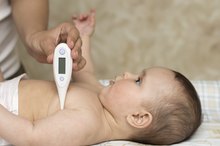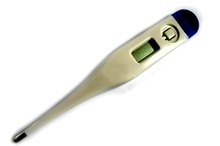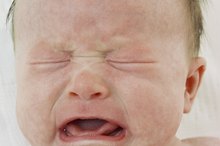When Is a Child's Temperature Considered Dangerous?
Otherwise healthy children often develop a fever as part of the body's natural response to an infection. In most cases, a fever does not endanger the child but is merely a symptom that signals the immune system is responding appropriately to the illness. However, extreme changes in body temperature -- high or low -- can be dangerous and may require emergency medical evaluation and care.
Measurement Options
Taking an accurate measurement is the first step in determining whether your child's temperature is at a dangerous level. The most accurate way to check body temperature in an infant or young child is with a digital rectal (in the child's bottom) thermometer, as recommended by the American Academy of Pediatrics (AAP). By age 4 or 5, you can switch to an oral digital thermometer because the child is old enough to hold it under the tongue with the mouth closed for the necessary length of time. The AAP also recommends use of a digital axillary (armpit) thermometer or a tympanic (ear) thermometer for children older than 3 months, although these methods are less accurate than a rectal or oral measurement. The AAP does not currently recommend other types of body temperature measurement devices for children.
- Taking an accurate measurement is the first step in determining whether your child's temperature is at a dangerous level.
- The most accurate way to check body temperature in an infant or young child is with a digital rectal (in the child's bottom) thermometer, as recommended by the American Academy of Pediatrics (AAP).
Dangerously High Fever
Causes for a Low Grade Fever in a Child
Learn More
The danger level for a fever depends on your child's age. For babies younger than 3 months old, the AAP recommends that you contact your doctor immediately if the digital rectal temperature is 100.4 F (38.0 C) or higher -- even if the baby doesn't seem sick or have other symptoms. For children 3 to 6 months, contact your doctor right away if the baby's rectal temperature reaches 102.0 F (38.8 C), regardless of whether other symptoms are present. Also contact your doctor without delay if a child of any age spikes a fever of 104.0 F (40.0 C) more than once.
A fever of 105.0 F (40.6 C) or higher constitutes a medical emergency in a child of any age because the cells of the body can be damaged or die with even short-term exposure to a temperature of 105.8 F (41 C). Call 9-1-1 or take your child to the nearest emergency room if the body temperature rises to or is approaching this level.
- The danger level for a fever depends on your child's age.
- For babies younger than 3 months old, the AAP recommends that you contact your doctor immediately if the digital rectal temperature is 100.4 F (38.0 C) or higher -- even if the baby doesn't seem sick or have other symptoms.
Heat Exhaustion and Heat Stroke
Heat exhaustion usually develops due to profuse sweating without adequate fluid replacement. It usually occurs in hot, humid weather. Children involved in sports may be particularly susceptible because active muscle generate large amounts of heat. Typical symptoms include:
- heavy sweating
- clammy skin
- weakness
- tiredness
- muscle cramps
- nausea
- vomiting,
- headache
There might be a fever, usually no higher than 102.0 F (38.8 C) -- but importantly, not every child with heat exhaustion has a fever. Urgent treatment is needed to prevent progression to heat stroke regardless of the presence or absence of a low fever. Oral rehydration and cooling are the cornerstones of treatment.
- Heat exhaustion usually develops due to profuse sweating without adequate fluid replacement.
- Children involved in sports may be particularly susceptible because active muscle generate large amounts of heat.
Dangerously Low Body Temperature
High Fever Lasting More Than Five Days in Children
Learn More
If your child is younger than 3 months, a lower-than-normal body temperature may indicate a potentially dangerous infection. Contact your doctor immediately if your baby is less than 12 weeks old and has a rectal temperature less than 97.9 F (36.6 C). In children older than than 3 months, accidental hypothermia due to environmental causes is the primary concern. Hypothermia is defined as a rectal temperature of less than 95.0 F (35.0 C). Infants and toddlers are more susceptible to hypothermia than older children and adults because they lose body heat more quickly 4. Additionally, infants are less able to generate body heat due to absent or limited shivering.
Hypothermia requires emergency medical care. Signs and symptoms vary depending on the severity of hypothermia and may include:
- If your child is younger than 3 months, a lower-than-normal body temperature may indicate a potentially dangerous infection.
- Contact your doctor immediately if your baby is less than 12 weeks old and has a rectal temperature less than 97.9 F (36.6 C).
Other Considerations and Warnings
Body temperature is just one factor to be considered if your child is sick. Some minor illnesses can cause a relatively high fever without posing a serious health threat. Conversely, some serious illnesses cause no fever or only a low-grade fever. If you child appears sick and you're concerned, call your doctor right away. Seek emergency medical care if your child has difficulty breathing, is difficult to awaken, appears confused or lethargic, or loses consciousness.
Reviewed and revised by: Tina M. St. John, M.D.
- Body temperature is just one factor to be considered if your child is sick.
- Seek emergency medical care if your child has difficulty breathing, is difficult to awaken, appears confused or lethargic, or loses consciousness.
Related Articles
References
- HealthyChildren.org: When to Call the Pediatrician: Fever
- FamilyDoctor.org: Fever in Infants and Children
- Health, Safety, and Nutrition for the Young Child, 9th Edition; Lynn R. Marotz
- Basic Life Support Provider: Pediatric Education for Prehospital Professionals; James M. Callahan
- Sullivan JE, Farrar HC. Fever and antipyretic use in children. Pediatrics. 2011;127(3):580-7. doi:10.1542/peds.2010-3852
- Chapman J, Arnold JK. Reye syndrome. In: StatPearls. Updated January 17, 2019.
- El-Radhi AS. Fever management: evidence vs current practice. World J Clin Pediatr. 2012;1(4):29-33. doi:10.5409/wjcp.v1.i4.29
Writer Bio
M. Gideon Hoyle is a writer living outside of Houston. Previously, he produced brochures and a wide variety of other materials for a nonprofit educational foundation. He now specializes in topics related to health, exercise and nutrition, publishing for various websites.









